Archived Storm Damage Blog Posts
Winter-Ready Success: Preparing Your Business for Winter Storms
1/3/2024 (Permalink)
As winter approaches, with its chilly embrace, businesses face unique challenges posed by winter storms. From snow accumulation to freezing temperatures, proper preparation is paramount to ensure the safety of employees, maintain operational continuity, and protect assets. In this blog, we'll explore essential steps for preparing your business for the winter storms that the Northeast often experiences.
Develop a Comprehensive Winter Emergency Plan
Start by creating a winter-specific emergency plan that addresses potential challenges such as power outages, transportation disruptions, and extreme weather conditions. Clearly communicate roles and responsibilities, including emergency contacts, evacuation procedures, and communication protocols.
Conduct a Winter Facility Check
Assess your business facility for vulnerabilities to winter weather. Check for proper insulation, inspect roofs for potential leaks or ice dam formation, and ensure that heating systems are in optimal condition. Address any issues that could pose risks during winter storms.
Winterize Your Business Vehicles
If your business relies on a fleet of vehicles, make sure they are winter-ready. Equip each vehicle with winter tires, inspect brakes and fluids regularly, and provide employees with winter driving safety training. Keep a supply of ice scrapers, snow brushes, and emergency kits in each vehicle.
Maintain Heating Systems
Regularly service and maintain heating systems to ensure they function efficiently during the winter months. Schedule professional inspections to identify and address any issues that could lead to heating failures when they are needed most.
Stock Emergency Supplies
Prepare for potential power outages by stocking emergency supplies such as flashlights, batteries, blankets, and non-perishable food items. Ensure that employees know the location of emergency supplies and conduct drills to familiarize them with emergency protocols.
Monitor Weather Forecasts:
Stay vigilant by monitoring weather forecasts regularly. This allows you to anticipate potential disruptions and make informed decisions about business operations, employee safety, and possible closures or delays. With the rise of remote work, establish and test remote work options for your employees. This flexibility allows your business to continue operations even if winter storms make commuting challenging or if the physical workplace is inaccessible.
Communicate Proactively
Establish clear communication channels to keep employees informed about weather-related updates, closures, or changes to business operations. Utilize email, text messaging, and social media to ensure that critical information reaches everyone promptly. Develop a snow removal and de-icing plan for your business property. Ensure that walkways, parking lots, and entryways are promptly cleared of snow and ice to maintain a safe environment for employees and clients.
Review and Update Insurance Coverage
Regularly review your business insurance coverage to ensure it adequately protects against winter-related damages. Understand the terms of your policy, including coverage for snow-related incidents, and make adjustments as needed.
Train Employees on Winter Safety Protocols
Conduct winter safety training sessions for employees, covering topics such as safe driving in winter conditions, preventing slips and falls, and recognizing signs of cold-related illnesses. Empower employees to prioritize their safety during winter storms. Stay connected with local emergency management authorities and stay informed about community storm preparedness efforts. This collaboration can provide valuable resources and support during challenging times.
Winter storms may be inevitable, but with careful planning and proactive measures, your business can navigate the challenges they present. By prioritizing employee safety, maintaining operational resilience, and preparing for potential disruptions, you position your business for winter-ready success, ensuring that it withstands the chill and continues to thrive despite the challenges of the season.
Severe Weather Outages: Ensuring Safety and Comfort During Storms
9/18/2023 (Permalink)
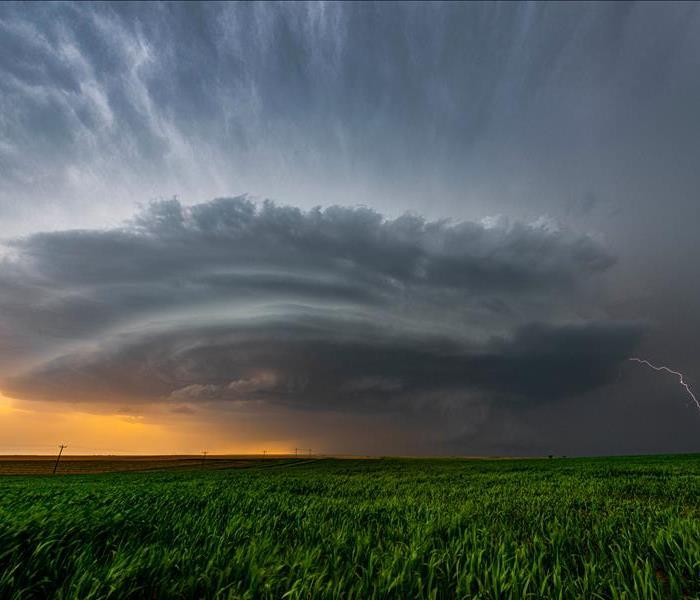 Keep yourself updated about weather forecasts and storm alerts.
Keep yourself updated about weather forecasts and storm alerts.
As a homeowner or property owner, preparing for severe weather outages is crucial to safeguarding your family's safety and ensuring maximum comfort during storms. Severe weather events, such as hurricanes, blizzards, or thunderstorms, can lead to power outages, making it essential to have a well-thought-out plan in place. In this article, we'll explore practical steps you can take to ensure safety and comfort during these challenging times.
Develop an Emergency Plan
Creating a comprehensive emergency plan is the first step in preparing for severe weather outages. Involve all members of your household in the planning process and discuss roles and responsibilities during emergencies. Your plan should include:
Identifying safe areas: Designate shelter spaces within your home that offer protection from severe weather, such as basements or interior rooms away from windows.
Emergency contact list: Prepare a list of emergency contacts, including local authorities, utility companies, and family members. Keep this list accessible to everyone.
Evacuation routes: Familiarize yourself with evacuation routes in your area and establish a meeting point outside your home where everyone can gather in case of evacuation.
Essential supplies: Stock up on emergency supplies like non-perishable food, water, first-aid kits, flashlights, batteries, and necessary medications.
Backup Power Solutions
Investing in a backup power solution is a smart decision to maintain some level of comfort during power outages. Consider the following options:
Generators: Portable or standby generators can provide electricity during extended outages. However, make sure to follow safety guidelines and use them outdoors to avoid carbon monoxide poisoning.
Solar-powered chargers: Utilize solar-powered chargers to keep essential devices like smartphones and flashlights powered up during prolonged power cuts.
Secure Your Property
Protecting your home or property from severe weather damage can minimize the impact of storms. Here are some measures to consider:
Roof and gutter maintenance: Regularly inspect and maintain your roof and gutters to ensure they are in good condition. Properly installed and maintained gutters can prevent water damage during heavy rain.
Trim trees and branches: Prune trees near your property to minimize the risk of falling branches during storms. Overhanging limbs can cause significant damage to your home and power lines.
Reinforce windows and doors: Install storm shutters or board up windows and doors to protect against flying debris and high winds.
Stay Informed
Keep yourself updated about weather forecasts and storm alerts. Use weather apps or tune into local news channels for real-time information. Staying informed will give you ample time to activate your emergency plan if severe weather is approaching.
Collaborate with Neighbors
Creating a sense of community and collaboration with your neighbors can be immensely helpful during severe weather outages. Look out for each other and offer assistance when needed. Sharing resources and information can make the recovery process smoother for everyone.
Severe weather outages can be challenging, but with proper preparation and planning, you can ensure the safety and comfort of your family and property during storms. Develop a detailed emergency plan, invest in backup power solutions, secure your property, stay informed, and collaborate with neighbors. By taking these proactive measures, you can confidently weather any storm that comes your way. Stay safe and be prepared!
Exploring Flood Damage Coverage: Does Homeowners Insurance Protect You?
7/10/2023 (Permalink)
 Make sure you have the appropriate flood insurance coverage to protect your property.
Make sure you have the appropriate flood insurance coverage to protect your property.
As a homeowner, protecting your property from unexpected disasters is a top priority. Among the potential threats, flooding can cause significant damage and financial strain. Many homeowners wonder whether their standard homeowners insurance policy covers flood damage. In this blog post, we will delve into the topic of flood damage coverage, helping you understand the extent of protection offered by homeowners insurance and the importance of additional flood insurance to safeguard your home and belongings.
Standard Homeowners Insurance and Flood Damage
It's crucial to note that standard homeowners insurance policies typically do not cover damage caused by floods. These policies are designed to protect against specific risks, such as fire, windstorms, or theft. Flood damage is considered a separate peril that requires specialized coverage due to its unique nature and potential for widespread devastation. Understanding the limitations of your standard policy will help you make informed decisions regarding flood protection.
Defining Flood Damage
To better understand flood insurance, it is important to define what constitutes a flood. In insurance terms, a flood is defined as an excess of water that covers normally dry land. This can result from heavy rainstorms, overflowing rivers or lakes, tidal surges, or rapid snowmelt. Even a few inches of water can cause significant damage to your home's structure, foundation, electrical systems, and personal belongings.
The Benefits of Flood Insurance
Securing flood insurance offers several key benefits for homeowners. First and foremost, it provides financial protection in the event of a flood, covering the costs associated with repairing or rebuilding your home and replacing damaged belongings. Flood insurance can help you recover more quickly and minimize the financial burden often associated with flood-related losses.
Assessing Your Flood Risk
Evaluating your flood risk is a crucial step in determining the necessity of flood insurance. FEMA provides Flood Insurance Rate Maps (FIRMs) that identify areas at different levels of flood risk. These maps can help you understand the likelihood of flooding in your area and assess the need for adequate coverage. Keep in mind that even properties outside high-risk zones can still experience flooding, making flood insurance a valuable investment for most homeowners.
While standard homeowners insurance policies typically do not cover flood damage, it's essential to recognize the importance of obtaining flood insurance to protect your home and belongings. Floods can happen anywhere, and the costs associated with repairs and recovery can be significant. By understanding the limitations of your existing policy and assessing your flood risk, you can make informed decisions about securing appropriate flood insurance coverage.
How Hail Can compromise Your Roof
7/28/2022 (Permalink)
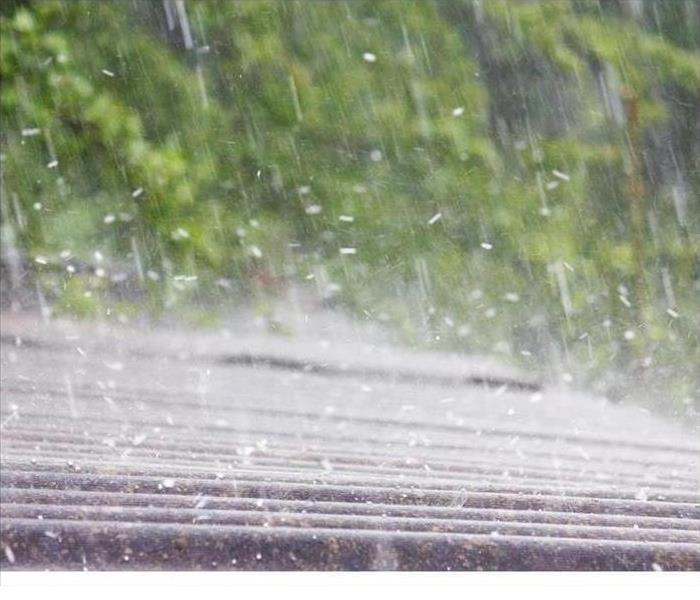 Hail storm in Llewellyn Park, NJ.
Hail storm in Llewellyn Park, NJ.
A healthy roof can protect your commercial property from storm damage in Llewellyn Park, NJ. Roof damage from a severe storm requires you to act quickly to avoid costly consequences.
How Can Hail Affect Your Roof?
Hail storms are typically not long-lasting, but they can severely compromise your roof depending upon various factors, including:
- Stone size
- Stone weight
- Stone shape
- Speed at Impact
- Roof material
Hailstones can have diameters up to three inches and weigh as much as a pound. They can form with jagged edges and travel over 100 miles per hour from thousands of feet above the ground. Damage occurs if these large stones land on your roof and puncture a hole through it.
How Can You Identify Hail Damage?
Roof damage following a hail storm is not always easy to recognize if it doesn't leave a gaping hole. Following a hail storm, it is necessary to conduct a roof inspection and look for the more subtle damage signs. Your roof may have damage if your gutters are out of place or dented or if they are not draining properly due to clogging from trapped hail particles. Dents in your building's siding following a hail storm are another good indication that your roof also has damage.
What Are the Consequences of Ignoring Roof Repairs?
Delaying roof inspections or hail damage repairs can lead to other issues affecting your building's interior. For example, a small hole in your roof can grow bigger if it remains unrepaired. As a result, water from the next rain or snowstorm could make its way inside. The result could be an obvious flood, water-soaked insulation or an accumulation of water within your building's interior walls. These scenarios can lead to secondary mold damage that would require immediate attention from a mold remediation service to decontaminate your premises.
If roof damage causes flooding at your building in Llewellyn Park, NJ, a disaster recovery service can undertake proper cleanup and sanitization.
Special Techniques That Aid Recovery After a Storm
5/1/2022 (Permalink)
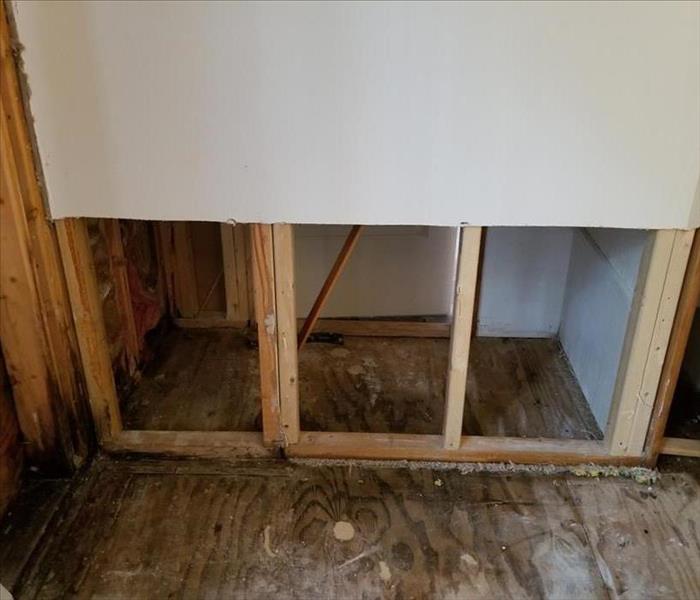 With industry-leading techniques and advanced equipment, SERVPRO professionals can quickly and efficiently restore your building after a flood.
With industry-leading techniques and advanced equipment, SERVPRO professionals can quickly and efficiently restore your building after a flood.
Special Techniques For Post-Storm Recovery
While your commercial building in Montclair NJ, might seem indestructible, in reality, it is at risk of powerful storms. Thunderstorms unleash lightning and high winds, while tornadoes produce winds of more than 100 miles per hour. As recent events have shown, hail storms can be truly destructive. Hurricanes often generate torrential rains that lead to flooding. All of these weather events put your facility at risk of damage. Fortunately, an experienced storm remediation company has the equipment and the knowledge to bring your company back from disaster. They often use specialized techniques during the restoration phase.
The Execution of a Tear Out
When water inundates your building, many materials become saturated with moisture. In some cases, normal drying is not sufficient, and a technique known as a flood cut is employed for repairing drywall and wall insulation. In the aftermath of flooding, technicians will perform the following actions:
- Remove all standing water
- Cut the drywall 12 inches above the flood line
- Remove all damaged wall insulation
- Completely dry out the area with fans
- Replace new insulation and drywall
This must be done to remove any contamination caused by floodwaters. It ensures the drywall and insulation will not later produce unpleasant odors or result in mold growth.
The Utilization of Professional Cleaning Methods
A professional restoration company will also use many different methods of cleaning and sanitizing areas of a building as well as the contents of a building. While some items such as clothes might need dry cleaning techniques, other items such as non-porous items can benefit from abrasive cleaning or foam cleaning. The technicians will determine the best method of cleaning for each item, and they will use a restore versus replace mentality when possible.
The recovery of your facility from flooding is a complicated process. Trained professionals can restore your building quickly and efficiently with industry-leading techniques and advanced equipment.
How to Remove Lingering Odors Caused by Water Damage
3/17/2022 (Permalink)
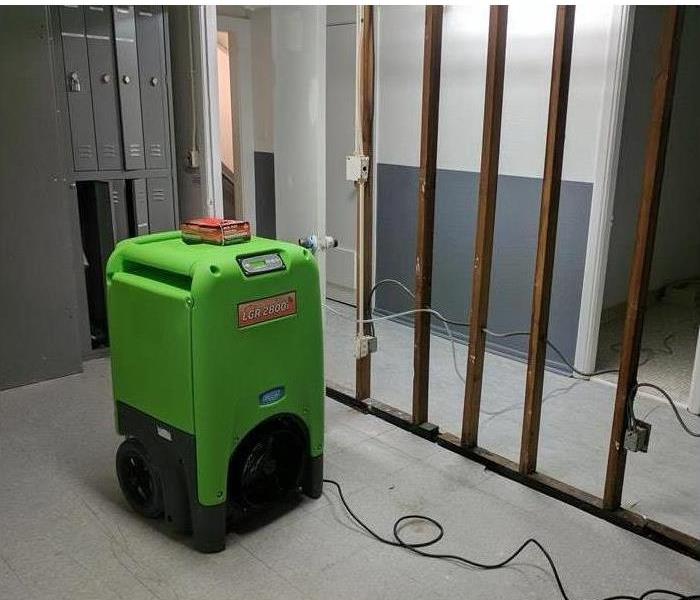 Materials like insulation and drywall can quickly absorb flood water. This is what causes scents to linger and structural damage.
Materials like insulation and drywall can quickly absorb flood water. This is what causes scents to linger and structural damage.
How To Get Rid Of Lingering Water Damage Odors
Water of all kinds can cause damage to your Montclair NJ, building. While contaminated water may be more likely to cause lingering odors, clean water can also contribute by facilitating mold growth. If you are noticing bad smells after water damage, the following steps can help remove it.
1. Clean Surfaces
Both flooding and sewage loss can bring contaminated water into your building. This can contain bacteria, mud, waste and other debris. As a result, it can carry with it unpleasant odors. Everything that this water has come into contact with should be thoroughly cleaned, both to reduce these odors as well as to prevent bacteria from spreading within the building.
2. Perform Mold Remediation
Mold spores that have been brought into the building by contaminated water, as well as those already present, will grow quickly in a wet environment. Infestations of this fungus can then create a musty odor. Both the mold growth and the smell can be effectively removed by a mold remediation company.
3. Replace Damaged Materials
Materials like insulation and drywall can easily absorb large amounts of flood water. These are not easily cleaned, resulting in bad smells that stick around as well as damage to the building. Removing and replacing these materials should reduce lingering odors.
4. Remove Odors From the Air
If you have tried the previous steps but still haven’t quite removed all of the bad smells, then you may need to clean the air inside the building. Using an air purifier, you can remove bacteria and other contaminants to create a clean and fresh-smelling environment.
After you have experienced water damage, it can take some time to return your building to its previous condition. Everything should be cleaned thoroughly and any mold growth should be removed. In most cases, it is best to have this done by a professional who has the necessary training and equipment to get the job done properly.
Helpful Sump Pump Maintenance Tips for Homeowners
1/18/2022 (Permalink)
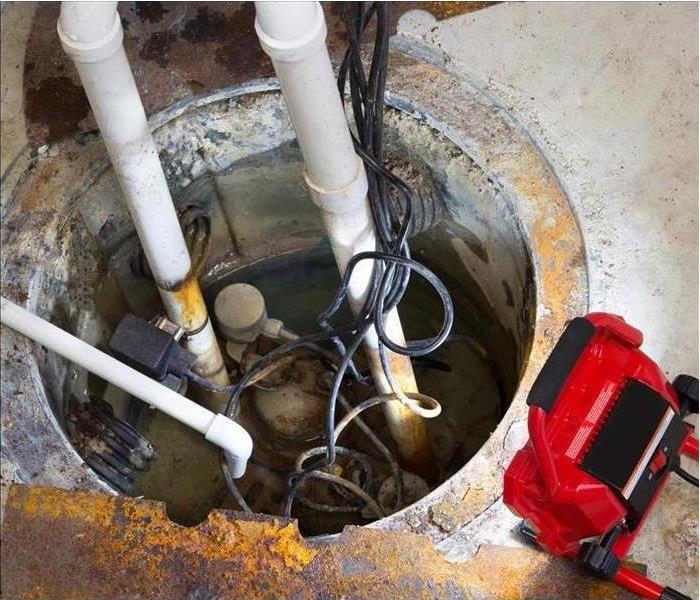 It's time to inspect your sump pump.
It's time to inspect your sump pump.
Helpful Sump Pump Maintenance Tips for Homeowners
As a homeowner in Glen Ridge, NJ, it might seem like the maintenance for your home never ends. Cleaning out the gutters and checking the roof for damage or leaks should already be part of your seasonal checklist, but have you thought to check your basement? More specifically, if heavy rains are in the forecast or spring is coming around the corner, it’s time to inspect your sump pump.
What Is It?
This device is used to remove any water that’s gathered in a sump basin, which is usually found in the basement. In the event of a basement flood, this pump is necessary to ensure that water is sent away from the house and into a place, such as a storm drain or dry well, where it will no longer be a concern.
How To Perform Pump Care
For your benefit and ease, you should be putting time aside every couple of months to confirm that your sump pump is working correctly. If you are unsure on how to go about conducting pump maintenance, look to the following tips:
• Occasionally flood the sump basin by pouring water into it to ensure the pump does what it’s supposed to do and drains the water quickly. Have it serviced if it doesn’t.
• Be sure that the pump is standing upright. Sometimes vibrations occur while the pump is running that can make it topple over or tilt to one side.
• Check the power cord to be sure it’s connected. It’s not uncommon for a breaker to trip in damp areas. If needed, reset the outlet.
The below can be limited to once a year:
- Clean out the sump.
- Check the manual (or online) to see if the pump bearings need grease or oil.
- Remove the pump from sump and clean and inspect it.
Learn Now, Protect Later
Though the preservation of your home is constant, the ease of knowing that you are capable of fixing your own sump pump is worthwhile. You can save time, money, and potential water damage to the rest of your home.






 24/7 Emergency Service
24/7 Emergency Service





